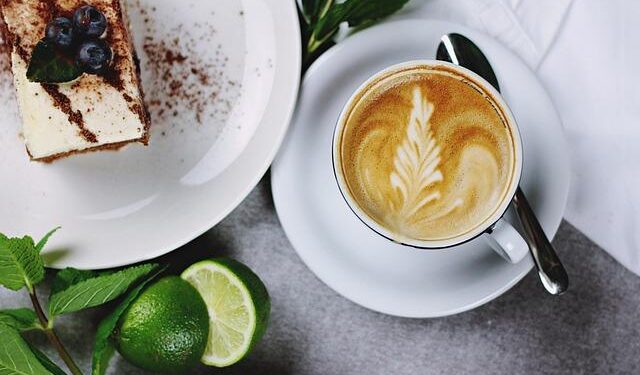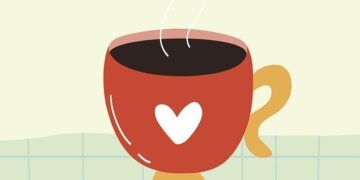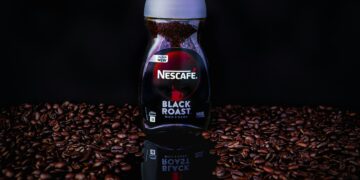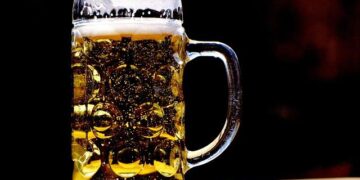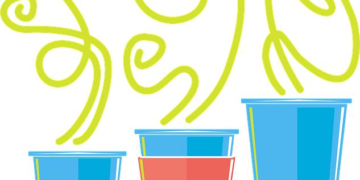Table of Contents
I used to think I knew coffee.
For years, my morning ritual was a frantic grab for whatever bag was on sale, guided by a vague notion that “dark roast” meant strong and “light roast” was for…
well, I wasn’t sure.
My goal was simple: a consistent, clean energy to start my day.
But my results were anything but consistent.
Some days I was buzzing with anxiety; other days, I felt nothing.
It was this frustration that sent me down a rabbit hole, a personal quest to understand what was really going on inside my cup.
This is the story of that journey, and the surprising truths I uncovered about the science behind our favorite brew.
The Short Answer: Your Daily Cup, Demystified
Before we get into the weeds, let’s get the most common questions out of the way. If you’re just here for the numbers, here they are.
An average 8-ounce (237 mL) cup of medium roast coffee, brewed using a standard drip method at home, contains about 95 milligrams (mg) of caffeine.1
However, that 95 mg figure is just a starting point.
The reality is that the caffeine content in your cup can vary wildly, typically falling within a range of 70 mg to 140 mg.1
Some analyses of drip coffee even place the upper end closer to 165 mg.3
This variation has very little to do with whether the roast is light, medium, or dark.
Instead, it comes down to factors that are far more significant.
For anyone looking to actually manage their caffeine intake, there are two levers you can pull that have a much bigger impact than the color of the roast:
- The Type of Bean: The single most important factor is the coffee species. Coffea canephora, better known as Robusta, can contain nearly double the caffeine of the more common Coffea arabica.4
- The Serving Size: This one is obvious but often overlooked. A “cup” of coffee is not a standard unit. A 12-ounce mug from your cabinet or a 16-ounce “grande” from a cafe will contain proportionally more caffeine than a small 8-ounce serving.1
In short, if you’re trying to control the kick in your cup, stop worrying about the roast level.
Instead, pay attention to what your beans are made of and how much you’re actually drinking.
My Own Journey Down the Rabbit Hole
My deep dive into coffee began with a simple, frustrating problem.
I was chasing the perfect morning buzz—that clean, focused energy that makes you feel like you can conquer the world.
I’d buy a bag of medium roast and for a week, it would be perfect.
Then I’d switch to a dark roast, assuming its bold, “strong” flavor meant more caffeine, only to feel sluggish.
Then I’d read an article online claiming that light roasts actually had more caffeine because the roasting process “burns it off.” So, I’d buy a bag of light roast, which often tasted a bit sour to my palate, and feel a jittery, unfocused energy that wasn’t pleasant at all.6
I was stuck in a cycle of confusion.
The labels on the bags—”bright,” “bold,” “full-bodied”—were telling me about flavor, but they seemed to have no reliable connection to the effect I was looking for.
One specific medium roast from a local shop gave me a powerful, clean lift, while another that looked and smelled similar did almost nothing.
It felt like a total mystery.
This inconsistency drove me to ask a more fundamental question: What is really going on inside the bean when it’s roasted, and what happens in my brewer that determines the final kick? I was tired of guessing.
I wanted to understand the system, the physics, and the chemistry from the ground up.
The answers I found were not what I expected, and they started by completely dismantling the biggest myth in coffee.
The Great Roast Debate: Why We’re All Arguing About the Wrong Thing
The most common debate you’ll hear among coffee drinkers is about which roast level has more caffeine.
It’s a topic rife with misconceptions.
One camp believes that the intense, bitter flavor of a dark roast is a sign of higher caffeine content.6
The other camp argues that caffeine, being a delicate compound, is destroyed by heat, meaning lighter roasts must be more potent.7
As it turns out, both of these popular beliefs are fundamentally misguided.
The scientific reality is that caffeine is an incredibly stable molecule.
It doesn’t significantly degrade or “burn off” during the roasting process.8
Studies show that even under severe roasting conditions, the loss of caffeine is minimal, and this tiny loss is more than offset by the loss of other materials, like water.10
So, if the amount of caffeine in a single bean stays almost the same from light roast to dark roast, why does this debate persist?
My own “aha!” moment came one evening, far away from a coffee shop, while I was making popcorn.
I was watching the hard, dense little kernels transform into big, fluffy, airy pieces, and it suddenly clicked.
Roasting coffee is like popping corn.
Think about it:
- A green, unroasted coffee bean is like a popcorn kernel. It’s small, hard, and dense for its size.
- The roasting process applies heat, causing the bean to lose water and mass. As it loses this weight, it expands and puffs up, dramatically increasing its volume and becoming less dense.11 A dark roast bean is like a fully popped piece of popcorn—it’s much larger and lighter than the original kernel. A light roast bean is like a partially popped kernel—it has expanded less and remains denser.8
This simple analogy perfectly explains the “by scoop vs. by weight” paradox that fuels the entire roast debate.
The Paradox of Measurement: Scoop vs. Scale
The reason people can argue endlessly about this is that both sides can be correct, depending on one unstated variable: how you measure your coffee.
- Measuring by Scoop (Volume): Imagine you have two identical scoops. If you fill one with dense, unpopped kernels (light roast beans), you’ll get a lot of them in there. If you fill the other with big, fluffy pieces of popped corn (dark roast beans), you’ll fit far fewer individual pieces into the same space. Because a scoop of light roast contains more beans, it will have slightly more caffeine.8
- Measuring by Weight (Mass): Now, imagine you use a kitchen scale. If you measure out 20 grams of unpopped kernels (light roast), you’ll get a certain number of beans. To get 20 grams of light, airy popped corn (dark roast), you’ll need many more individual pieces to reach the same weight. Because a weighed dose of dark roast coffee contains more individual beans, it will have slightly more caffeine.8
So, who is right? Technically, both are.
But the most important takeaway is that the difference is, in practical terms, negligible.
One study comparing brewed coffee found that a sample of light roast had about 60 mg of caffeine, while the same amount of dark roast had 51 mg.7
Another analysis estimated a tiny 6 mg difference between an 8-ounce cup of light roast and dark roast.16
This whole debate, while scientifically interesting, is a red herring for the average coffee drinker.
The real lesson isn’t about which roast to choose, but about the importance of consistency.
If you want a predictable amount of caffeine in your cup every day, the single best thing you can do is stop using a scoop and start measuring your coffee with a scale.
How you measure has a bigger impact than the color of the roast itself.
This realization was my first major step toward taking control of my coffee, and it led me to the next, even bigger discovery.
It’s in the Genes: The Single Biggest Factor in Your Coffee’s Kick
After realizing that the roast level was a distraction, I started looking at the bags of beans themselves.
I’d noticed two words appearing over and over again: “Arabica” and “Robusta.” I had always assumed they were just different brands or origins, like “Colombian” or “Ethiopian.” I couldn’t have been more wrong.
Discovering the difference between these two species was like finding the Rosetta Stone of coffee.
It explained everything.
The vast majority of coffee in the world comes from two distinct species of plant: Coffea arabica (Arabica) and Coffea canephora (Robusta).
And when it comes to caffeine, they are not created equal.
Not even close.
- Arabica beans, which account for over 60% of the world’s coffee, have a caffeine content of approximately 1.2% to 1.5% by weight.4
- Robusta beans, the second most produced species, contain between 2.2% and 2.7% caffeine by weight.5 Some sources even report averages as high as 2.9 mg per bean compared to Arabica’s 1.9 mg.19
Let that sink in.
On average, Robusta beans pack nearly double the caffeine of Arabica beans.
This genetic difference is the single largest variable in the caffeine content of your coffee, dwarfing the minuscule effects of roasting.
A medium roast made from Robusta beans will deliver a much bigger jolt than a light or dark roast made from Arabica.
This genetic divergence doesn’t just affect caffeine; it shapes the entire character of the bean, from its flavor to the way it’s grown.
This is where the story gets really interesting, because the high caffeine content of Robusta isn’t just a feature for us; it’s a crucial survival mechanism for the plant.
Caffeine is toxic to most insects, acting as a natural pesticide.17
This chemical defense makes the Robusta plant incredibly hardy, or “robust.”
This fundamental difference leads to a cascade of other distinctions that influence everything from the taste in your cup to the price you pay at the store.
Table 1: The Tale of Two Beans: Arabica vs. Robusta at a Glance
| Feature | Arabica | Robusta |
| Average Caffeine % | 1.2% – 1.5% 17 | 2.2% – 2.7% 4 |
| Flavor Profile | Nuanced, aromatic, sweet, fruity, floral 17 | Strong, bold, bitter, often “rubbery” or “chocolatey” 5 |
| Acidity | Higher, brighter | Lower |
| Sugar Content | Nearly double that of Robusta 17 | Lower |
| Lipids (Oils) | About 60% more than Robusta 17 | Lower |
| Growing Conditions | High altitudes (1,800-6,300 ft), mild temps (59°F+) 5 | Low altitudes (600-2,400 ft), hot temps (~80°F) 5 |
| Hardiness | Delicate, susceptible to pests and disease | Very hardy, disease-resistant (due to high caffeine) 17 |
| Common Uses | Specialty single-origin coffee, high-end blends | Instant coffee, filler in ground coffee, espresso blends 5 |
| Price Point | Higher | Lower |
This table reveals a clear story.
Arabica is the delicate, high-maintenance, premium species prized for its complex and pleasant flavors.
Robusta is the workhorse: tough, high-yield, and cheap to produce, with a powerful caffeine kick but a less refined, more bitter flavor.
This explains why you find Robusta in specific places.
Its low cost and high caffeine make it the perfect candidate for instant coffee and a common, unnamed filler in pre-ground coffee blends.
It’s also a key component in traditional Italian espresso.
That thick, stable, reddish-brown crema on top of a classic espresso shot? That’s largely thanks to Robusta.5
This was the answer to one of my personal mysteries.
I remembered an espresso I had at a small, old-school cafe in Rome.
It delivered a powerful, almost shocking jolt of energy that was completely different from the lattes I was used to.
I now realize I was experiencing a classic Italian espresso blend, which likely had a significant percentage of Robusta.
The goal wasn’t just flavor; it was a potent, efficient delivery of caffeine.
Understanding the Arabica vs. Robusta divide was a game-changer.
It taught me to read the bag more carefully.
If it says “100% Arabica,” I know I’m getting a standard caffeine level.
If it doesn’t specify, or if it’s an espresso blend designed for a strong kick, there’s a good chance Robusta is in the mix.
But the bean is only half the story.
The final piece of the puzzle lay in what I was doing right on my own kitchen counter.
The Brewer’s Touch: How You Turn Beans into Buzz
Even with the right beans measured on a scale, I noticed that the way I brewed my coffee seemed to change its character.
A French press felt heavier and bolder than a pour-over.
An espresso was a tiny, intense lightning bolt.
I needed to understand the final step in the process: extraction.
Coffee extraction is what happens when hot water meets ground coffee.
The water acts as a solvent, dissolving hundreds of soluble compounds out of the coffee grounds and carrying them into your cup.
These compounds include the acids that give coffee its brightness, the sugars that provide sweetness, the lipids (oils) that create body and mouthfeel, and of course, caffeine.20
The efficiency of this extraction process is governed by four main variables:
- Temperature: Hotter water is a more efficient solvent. The ideal range is typically 196–201 °F (91–94 °C).20
- Time: The longer the water is in contact with the coffee, the more it can extract.
- Grind Size: Finer grounds have more surface area, allowing for faster and more efficient extraction.20
- Pressure: Unique to methods like espresso, pressure forces water through the grounds, dramatically increasing extraction efficiency.22
A common myth here is that a much longer brew time will always lead to a much more caffeinated cup.
While time is a factor, caffeine is one of the most water-soluble compounds in coffee and is extracted very early in the brewing process.20
So, while a 4-minute French press will extract more total compounds than a 2-minute pour-over, the difference in
caffeine specifically is often marginal.23
The major differences between brew methods lie more in flavor, body, and a crucial distinction I had been missing all along.
Concentration vs. Total Caffeine: The Whiskey and Beer Analogy
The key to understanding how different brewers affect your buzz is to separate two concepts: caffeine concentration (the amount of caffeine per ounce) and total caffeine (the total amount in your entire drink).
Think of it this way: a 1.5-ounce shot of whiskey is far more concentrated in alcohol (40% ABV) than a 12-ounce pint of beer (5% ABV).
But because the serving size is so different, they might end up containing a similar total amount of alcohol.
Coffee works the same Way. Some methods produce a highly concentrated but small drink, while others produce a less concentrated but much larger drink.
This distinction resolves nearly all the conflicting information you see online about which brewing method is “strongest.”
Let’s break it down method by method.
- Espresso: Using high pressure and a very fine grind, espresso extracts a huge amount of material in just 20-30 seconds. This results in the highest concentration of caffeine, with studies showing around 4.2 mg/mL, or roughly 60-65 mg in a single 1-ounce shot.22 It’s the whiskey shot of the coffee world.
- Drip / Pour-Over: This is the baseline. Using a medium grind and gravity, it produces a balanced extraction. The concentration is much lower than espresso (around 12-16 mg per ounce), but because the serving size is much larger (typically 8-12 ounces), the total caffeine is often higher than a single espresso shot, landing in that 95-175 mg range for an 8-ounce cup.3
- French Press: This is a full-immersion method, meaning the grounds steep in the water for the entire brew time (usually 4 minutes). This produces a robust, full-bodied cup because the metal filter allows more oils and fine particles through than a paper filter does.25 Its
total caffeine is very similar to drip coffee, typically around 80-107 mg per 8-ounce serving, but its flavor and mouthfeel are much heavier.3 - Cold Brew: This method flips the script by trading high temperature for extremely long contact time (12-24 hours). This slow, gentle extraction produces a coffee concentrate that is smooth, low in acidity, and very high in caffeine. While the final concentration depends on how much it’s diluted, a standard 8-ounce serving of cold brew can have one of the highest total caffeine contents, often ranging from 102 mg to over 180 mg.3
- AeroPress: This versatile brewer is a hybrid, combining immersion with pressure. Because the recipes for AeroPress vary so wildly (from short, espresso-like shots to longer, tea-like infusions), its caffeine content is highly adaptable. Generally, a standard cup will have a total caffeine content similar to or slightly higher than a French press, around 110-130 mg for an 8-ounce equivalent.27
This finally made sense of my own experiences.
The French press tasted stronger because of its heavy, oily body, but it wasn’t necessarily giving me more caffeine than my drip machine.
The espresso shot was an intense but fleeting buzz.
The key was to stop confusing the sensory experience of “strength” with the chemical measurement of caffeine.
Table 2: Your Brewer’s Footprint: Caffeine & Character by Method
| Brewing Method | Typical Grind | Brew Time | Extraction Mechanic | Caffeine Concentration (mg/oz) | Typical Total Caffeine (per serving) | Flavor Profile |
| Espresso | Very Fine | 20-30 sec | Pressure & Infusion | ~64 mg/oz 27 | ~64 mg (1 oz shot) | Intense, concentrated, rich, with crema |
| Drip/Pour-Over | Medium | 2-4 min | Infusion (Gravity) | ~12-22 mg/oz 3 | ~95-175 mg (8 oz cup) | Clean, balanced, highlights bean origin |
| French Press | Coarse | ~4 min | Full Immersion | ~25 mg/oz 27 | ~80-107 mg (8 oz cup) | Rich, full-bodied, heavy, oily 3 |
| Cold Brew | Coarse | 12-24 hrs | Full Immersion (Cold) | ~15-23 mg/oz 3 | ~102-180 mg (8 oz cup) | Smooth, mellow, low acidity, sweet |
| AeroPress | Fine-Medium | 1-3 min | Immersion & Pressure | ~18 mg/oz 27 | ~110-130 mg (8 oz cup) | Versatile: clean like drip or rich like press |
Putting It All Together: Designing Your Perfect Caffeinated Experience
My journey down the coffee rabbit hole started with frustration and ended with clarity.
I realized that the cup of coffee I was drinking every morning wasn’t a product of luck or mystery; it was the result of a clear, predictable system.
The roast level I had been so obsessed with was just a minor detail.
The real power lay in understanding the beans, the brewer, and the dose.
This knowledge transformed my relationship with coffee.
I was no longer a passive consumer, blindly grabbing a bag off the shelf.
I was an active participant, an architect of my own morning ritual.
And you can be, too.
If you want to move beyond guessing and finally take control of your coffee’s effect, here is the blueprint I now use every day.
The Caffeine Control Blueprint
Forget the myths and focus on the three steps that truly matter.
Step 1: Choose Your Effect (The Bean)
This is your foundation.
Before you do anything else, decide on the caffeine level you want.
- For a Standard Buzz: Make sure your bag says “100% Arabica.” This is the global standard for specialty coffee and will give you a predictable, moderate level of caffeine. You can then fine-tune the flavor by choosing origins you like (e.g., fruity Ethiopian, chocolatey Brazilian).
- For a High-Octane Kick: Look for beans with Robusta. If you’re buying an espresso blend, check the description for mentions of a “classic Italian style,” “thick crema,” or “extra kick,” which often implies a Robusta component. Some roasters even sell 100% Robusta beans for those seeking the maximum possible jolt.
Step 2: Choose Your Experience (The Brewer)
With your desired caffeine level set by the bean, now you can choose your brew method based purely on the taste and texture you enjoy.
- For a Clean, Clear, Nuanced Cup: Use a brewer with a paper filter, like a pour-over (V60, Chemex) or a standard drip coffee machine. The paper traps most of the oils, resulting in a cup that highlights the delicate flavor notes of the bean.
- For a Rich, Heavy, Full-Bodied Cup: Use a brewer with a metal filter, like a French Press. This allows the natural oils and some fine sediment into the cup, creating a much heavier texture and a bold flavor profile.
- For a Quick, Intense Shot: Use an espresso machine. This is for when you want a concentrated flavor bomb.
- For a Smooth, Low-Acidity Drink: Use the cold brew method. This is ideal for those who find hot coffee too acidic or bitter, and it produces a potent concentrate perfect for iced coffee.
Step 3: Dial in the Dose (The Scale & Serving Size)
This is your final control knob.
The amount of ground coffee you start with (your dose) and the final volume of coffee you drink are the ultimate determinants of your total caffeine intake.
- Use a Scale: Ditch the scoop. Measuring your beans by weight (in grams) is the only way to ensure you are using the same amount of coffee every single time, eliminating the density variations between roasts.8 A standard ratio to start with is 1:16, meaning 1 gram of coffee for every 16 grams (or mL) of water.21
- Control Your Volume: Be mindful of your mug size. If a standard 8-ounce cup feels right, stick with it. If you find you’re still feeling too wired, don’t change your beans or your brewer—just use a slightly smaller dose or pour a smaller cup. If you need an extra boost, use a bit more coffee or a larger mug.
By following this simple, three-step process, you take the guesswork out of the equation.
You can have a rich, heavy French press made with 100% Arabica for a flavorful but standard buzz.
Or you can have a clean, light-bodied pour-over made with a Robusta blend for a surprisingly powerful kick.
The power is in your hands.
Coffee is no longer a mystery, but a system you can understand, control, and enjoy more deeply than ever before.
Works cited
- How Much Caffeine Is In Medium Roast Coffee? (ANSWERED …, accessed July 20, 2025, https://www.darkhorsecoffeecompany.com/blogs/coffee/how-much-caffeine-in-medium-roast-coffee
- Light vs Medium vs Dark Roast: Which Has More Caffeine? | Peet’s …, accessed July 20, 2025, https://www.peets.com/blogs/peets/how-much-caffeine-is-in-a-cup-of-coffee
- How Much Caffeine Is In Coffee?, accessed July 20, 2025, https://www.haymakercoffeeco.com/amount-of-caffeine-in-coffee
- stonestreetcoffee.com, accessed July 20, 2025, https://stonestreetcoffee.com/blogs/brooklyn-coffee-academy/robusta-is-the-most-caffeinated-coffee-bean-type-and-if-you-re-not-drinking-it-you-re-missing-out#:~:text=Arabica%2C%20the%20most%20popular%20coffee,and%20more%20naturally%20bitter%20flavor.
- Why you should Drink Robusta Coffee Beans | Stone Street Coffee, accessed July 20, 2025, https://stonestreetcoffee.com/blogs/brooklyn-coffee-academy/robusta-is-the-most-caffeinated-coffee-bean-type-and-if-you-re-not-drinking-it-you-re-missing-out
- Is it true that dark roast coffee has less caffeine than medium roasts? – Quora, accessed July 20, 2025, https://www.quora.com/Is-it-true-that-dark-roast-coffee-has-less-caffeine-than-medium-roasts
- Light Roast vs. Dark Roast Coffee: Nutrition and Caffeine – Healthline, accessed July 20, 2025, https://www.healthline.com/nutrition/light-vs-dark-roast-coffee
- Light vs Dark: Caffeine Content in Coffee Roasts – Bellwood Coffee, accessed July 20, 2025, https://bellwoodcoffee.com/blogs/roaster-notes/light-v-dark-caffeine-content-in-coffee-roasts
- How does roasting coffee affect the caffeine content? – Quora, accessed July 20, 2025, https://www.quora.com/How-does-roasting-coffee-affect-the-caffeine-content
- How Much Caffeine in a Cup of Coffee? – Espresso & Coffee Guide, accessed July 20, 2025, https://espressocoffeeguide.com/how-much-caffeine-in-a-cup-of-coffee/
- Density of green coffee beans & how it affects the roast – MTPak Coffee, accessed July 20, 2025, https://mtpak.coffee/2022/10/density-of-green-coffee-beans-how-it-affetcs-roast/
- Does Light Roast Coffee Really Have More Caffeine Than Dark Roast? – Valor Coffee, accessed July 20, 2025, https://valor.coffee/blog/does-light-roast-coffee-really-have-more-caffeine-than-dark-roast
- Coffee Roasting Levels and Caffeine Content | Lingonberry …, accessed July 20, 2025, https://www.lingonberrycafe.com/s/stories/coffee-roasting-levels-and-caffeine-content
- WHICH ROAST HAS MORE CAFFEINE? – Kicking Horse Coffee, accessed July 20, 2025, https://kickinghorsecoffee.com/pages/which-roast-has-more-caffeine
- A Bit About Caffeine – CoffeeGeek, accessed July 20, 2025, https://coffeegeek.com/blog/techniques/a-bit-about-caffeine/
- The Ultimate Guide: Caffeine Content in Different Coffee Roasts, accessed July 20, 2025, https://aerialresupplycoffee.com/blogs/the-resupply-blog/the-ultimate-guide-caffeine-content-in-different-coffee-roasts-1
- The difference between the coffee types of Arabica and Robusta – Lavazza, accessed July 20, 2025, https://www.lavazzausa.com/en/recipes-and-coffee-hacks/difference-type-arabica-robusta-coffee
- What Coffee Has the Most Caffeine? Strongest Beans & Brews – CAFELY, accessed July 20, 2025, https://cafely.com/blogs/info/what-coffee-has-the-most-caffeine
- Caffeine Levels in Coffee | How Much Caffeine in Coffee | Coffee.org, accessed July 20, 2025, https://coffee.org/pages/caffeine-levels-in-coffee-how-much-caffeine-in-coffee
- Coffee extraction – Wikipedia, accessed July 20, 2025, https://en.wikipedia.org/wiki/Coffee_extraction
- Understanding Coffee Extraction & Other Key Brewing Concepts …, accessed July 20, 2025, https://royalcoffee.com/understanding-coffee-extraction-other-key-brewing-concepts/
- Which brewing method has the most caffeine? – Redber Coffee, accessed July 20, 2025, https://www.redber.co.uk/blogs/blog/which-brewing-method-has-the-most-caffeine
- Caffeine yield of different brewing method? : r/Coffee – Reddit, accessed July 20, 2025, https://www.reddit.com/r/Coffee/comments/4161m3/caffeine_yield_of_different_brewing_method/
- Which coffee brewing method has the most caffeine? – Per’La Specialty Roasters, accessed July 20, 2025, https://drinkperla.com/blogs/news/which-coffee-brewing-method-has-the-most-caffeine
- The Ultimate Brew Down: Aeropress vs. French Press – Handground, accessed July 20, 2025, https://handground.com/grind/ultimate-brew-down-aeropress-vs-french-press
- Which Brew Method Has the Most Caffeine? – YouTube, accessed July 20, 2025, https://www.youtube.com/watch?v=J700sLKkn4M
- Caffeine vs. Coffee Brew Style – Koffee Kult, accessed July 20, 2025, https://www.koffeekult.com/blogs/articles/caffeine-vs-coffee-brew-style
